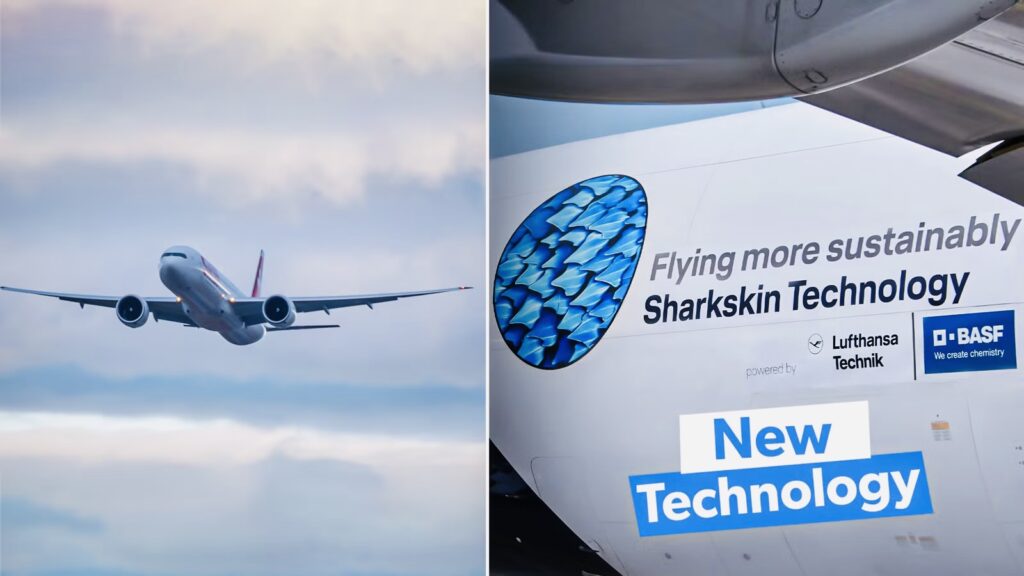Global Avionics Round-Up from Aircraft Value News (AVN)

Pictured: Left, an Airbus A330 airliner. Right, a Boeing 777F with the AeroSHARK skin added to reduce drag. (Photo: Lufthansa Technik)
Older widebodies rarely earn good headlines. Their values fade as newer generations roll off the line, and lease rates drift downward in lockstep. But in August 2025, the story shifted when HAECO announced it had begun certification work to apply AeroSHARK riblet film to Airbus A330-200 and -300 aircraft.
The drag-reducing surface technology has already proven itself on other types, but its potential application to the A330ceo could do more than cut fuel bills. It would also trigger changes inside the cockpit and avionics suite.
As explained below, these avionics updates are just as critical as the physical retrofit.
Skin Friction Meets Flight Management
AeroSHARK works through microscopic riblets etched into a film that’s applied to the fuselage and engine nacelles. By reducing skin friction, the aircraft enjoys lower drag and, by extension, lower fuel burn.
The technology was developed by Lufthansa Technik and chemical and coatings manufacturer BASF.
For an aircraft the size of the A330, even a 1%–2% efficiency gain means millions saved over its service life. But efficiency isn’t simply aerodynamic; it must be translated into the aircraft’s flight management computers.
Dispatchers rely on accurate drag profiles for fuel and performance planning. Without avionics recalibration, the savings would remain theoretical, misaligning the data in flight management systems (FMS) with what the aircraft is actually doing.
That is why regulators will require not just aerodynamic proof but also cockpit validation. The A330’s flight manuals, performance databases, and electronic flight bags must all be updated.
Pilots will need training on what the new performance tables look like in practice, i.e. how a lighter fuel load might extend range or change step-climb profiles. Maintenance control systems, many of which feed into digital avionics health monitoring, must also account for the retrofit.
Certification, then, isn’t just about sticking riblets on an airframe. It’s about proving that every system, from dispatch software to cockpit displays, accurately reflects the modified performance envelope.
Echoes of the Winglet Era
The potential effect on asset values recalls the introduction of blended winglets for narrowbodies in the 2000s. Operators that updated their flight management systems to reflect winglet performance saw clear lease premiums; those that skipped the mod were left behind.
The same bifurcation could emerge with the A330. Frames with AeroSHARK and updated avionics could command better lease terms and stay in fleets longer. Those without would continue their slide down the secondary market, especially in fuel-sensitive regions.
The timing is fortuitous. Widebody demand is climbing, but production slots for new aircraft remain tight. Airlines in Asia, the Middle East, and Africa are in regions where flight operations are already digitally heavy; these operators are looking for affordable lift. If an A330ceo comes with not just a sharkskin retrofit but also fully updated avionics packages, the cockpit will look far less “last generation” to operators comparing options.
That means lessors and MROs have more to consider than the film itself. Training modules for pilots, dispatchers, and maintenance crews will have to roll out alongside the modification. Even subtle FMS changes require confidence in the cockpit before regulators will sign off.
The Value Proposition
For airlines, the math is straightforward: if fuel savings from recalibrated performance tables exceed the retrofit cost, AeroSHARK becomes a no-brainer. For lessors, the calculus includes downtime. Can the avionics updates and training be bundled into a heavy check to minimize opportunity costs? If so, the investment looks far more attractive.
The August development injected something the A330ceo market hasn’t had in years: optimism. With AeroSHARK, the cockpit itself becomes part of the value story. An older widebody isn’t just flying with sharkskin; it’s flying with recalibrated avionics that make the savings real.
Small riblets on the fuselage may be almost invisible, but the changes inside the flight deck will be highly visible to regulators, crews, and financiers alike. If certification clears, the A330ceo could graduate from yesterday’s news to tomorrow’s unexpectedly valuable workhorse.
This article first appeared in Aircraft Value News.
John Persinos is the editor-in-chief of Aircraft Value News.